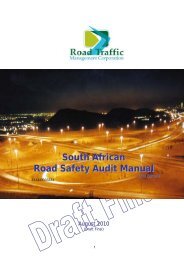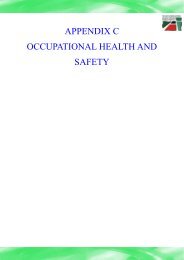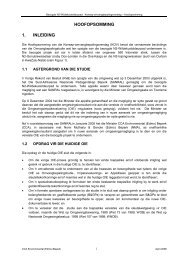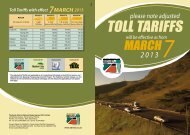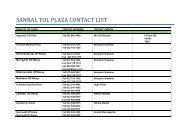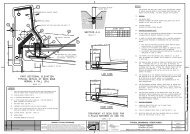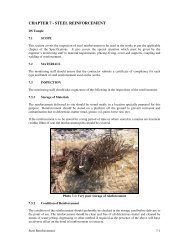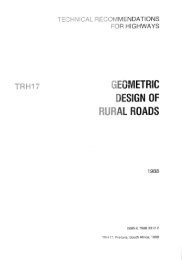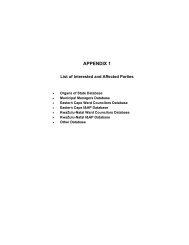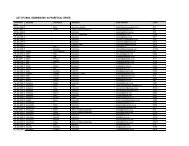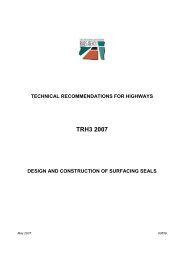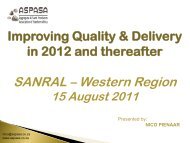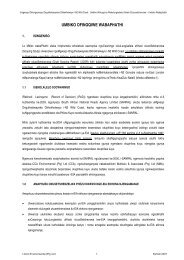SAPEM Chapter 2 - Sanral
SAPEM Chapter 2 - Sanral
SAPEM Chapter 2 - Sanral
You also want an ePaper? Increase the reach of your titles
YUMPU automatically turns print PDFs into web optimized ePapers that Google loves.
South African Pavement Engineering Manual<br />
<strong>Chapter</strong> 2: Pavement Composition and Behaviour<br />
8. FUNCTIONAL PERFORMANCE<br />
Performance can be described as: “the manner in which, or the efficiency with which, something fulfils its intended<br />
purpose”. The pavement engineer needs to be aware of how the distress types result in functional problems and<br />
the consequent effect on road users. Table 2 shows the links between the road user needs, functional parameters<br />
and behaviour measurements.<br />
Table 2.<br />
Road User Needs, Functional Parameters and Behaviour Measurements<br />
Road User Needs Functional Parameters Behaviour Measurements<br />
Safety<br />
Skid resistance<br />
Potholes<br />
Rutting<br />
Texture depth<br />
Number and age of potholes<br />
Rut depth<br />
Comfort Riding quality Roughness<br />
Environment Noise pollution Noise levels<br />
For example, safety translates into skid resistance that can be assessed by measuring texture depth. Potholes may<br />
also cause swerving of vehicles with resulting accidents. To mitigate dangerous potholes, SANRAL specifies in all its<br />
maintenance contracts that potholes shall be repaired within 24 hours.<br />
Comfort involves smoothness or riding quality that is measured with various devices such as non-contact laser<br />
profilometers and the values expressed as International Roughness Index (IRI) units. The pavement engineer will<br />
compare the measured values with the functional requirements. The requirements are established measures that<br />
define the boundaries between acceptable and unacceptable functional conditions. When a road’s condition crosses<br />
such a boundary, then some maintenance measure needs to be triggered. See <strong>Chapter</strong> 14 for more on triggering<br />
maintenance and rehabilitation activities.<br />
The appropriate maintenance action depends on the pavement type and layer strengths, as well as traffic loads and<br />
environmental conditions. For example, Figure 16 shows pumping of a stabilised base and relatively rapid<br />
development of roughness. Any crack sealing will have to accommodate fairly active crack movements to prevent<br />
further moisture ingress and associated roughness development.<br />
Figure 16. Pumping of Stabilised Base<br />
Figure 17 shows extensive surface cracking and surface potholes, but little development of deeper seated rutting,<br />
deformation and roughness. If this road surfacing could be repaired and sealed, the pavement may provide many<br />
years of life before its serviceability drops below acceptable levels.<br />
Section 8: Functional Performance<br />
Page 22



